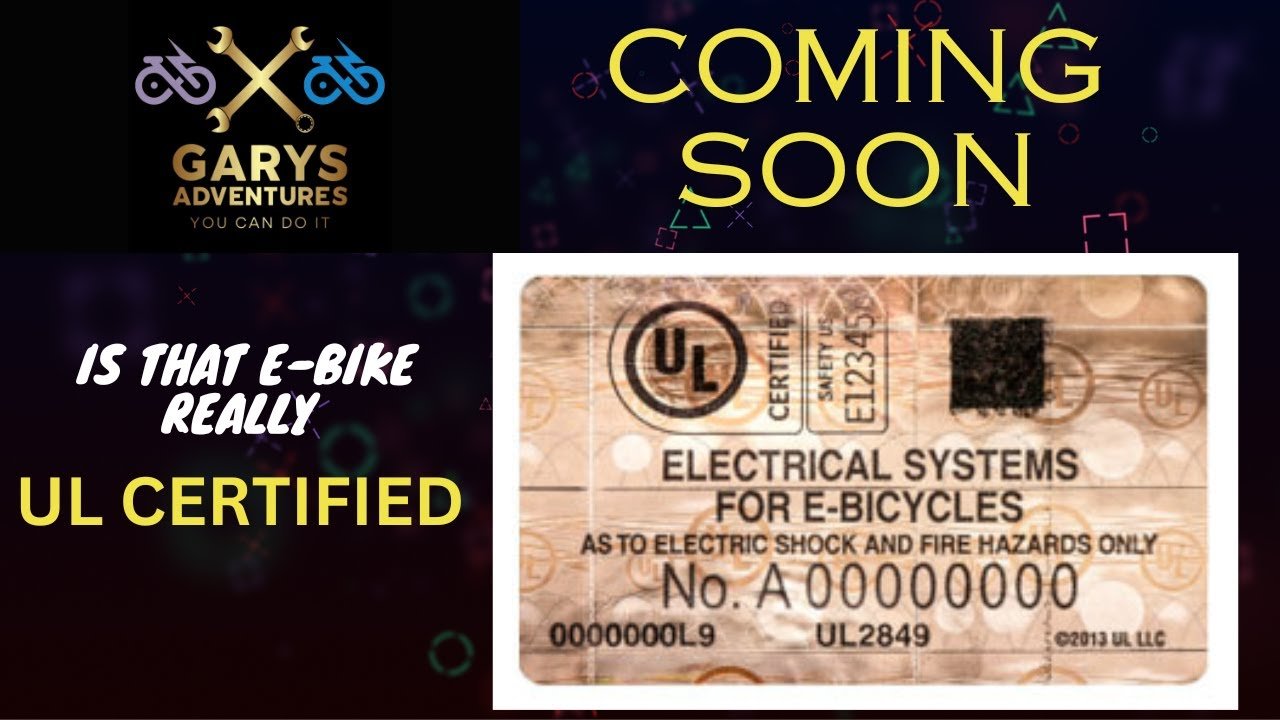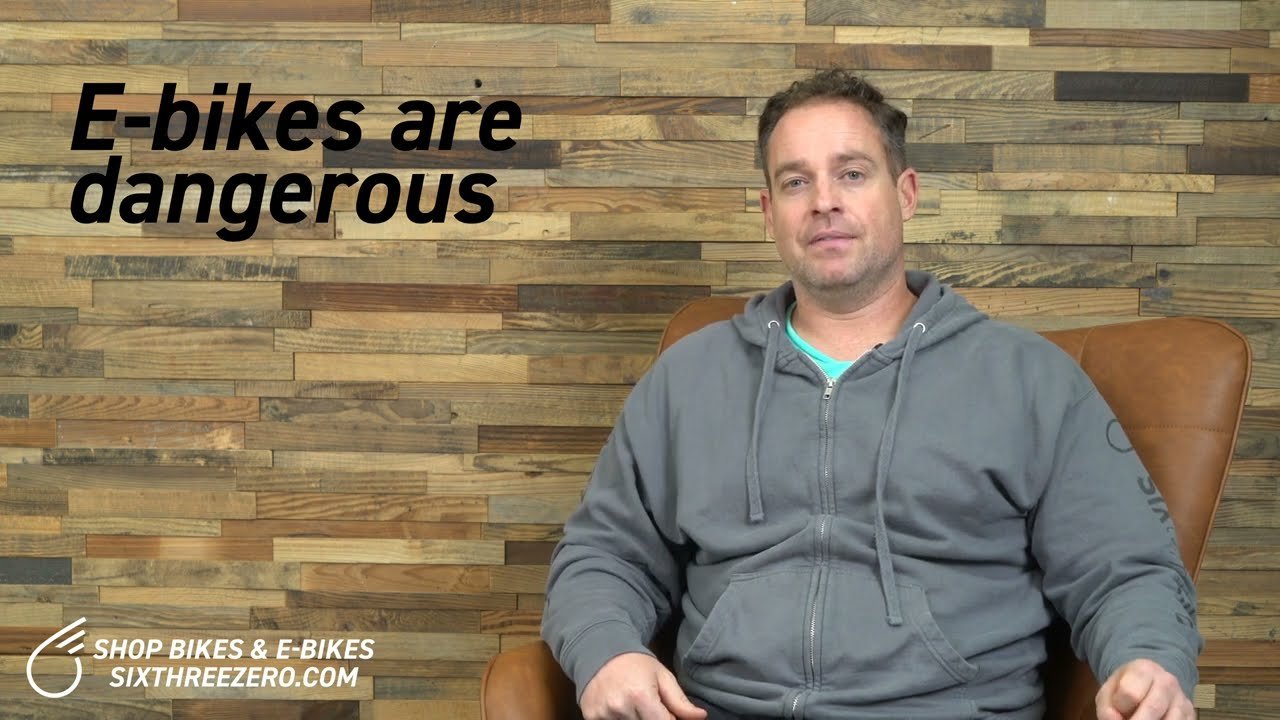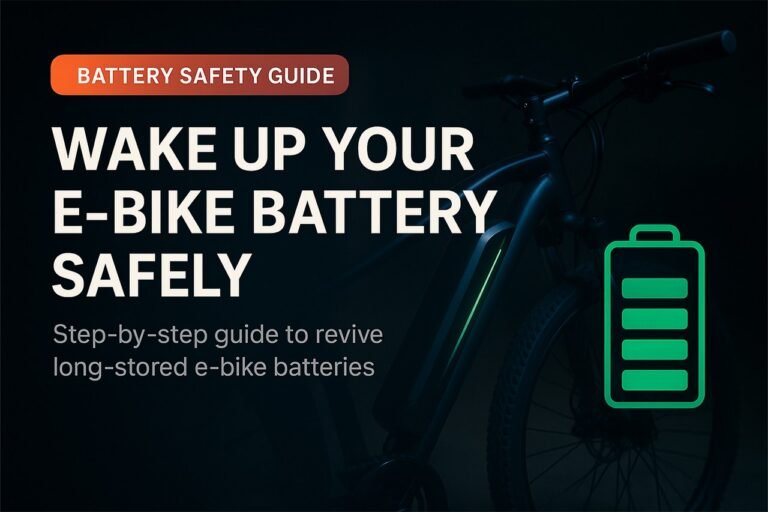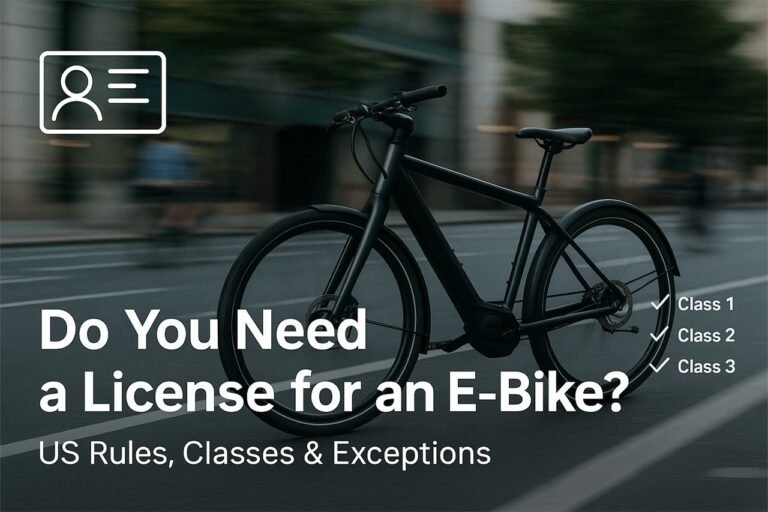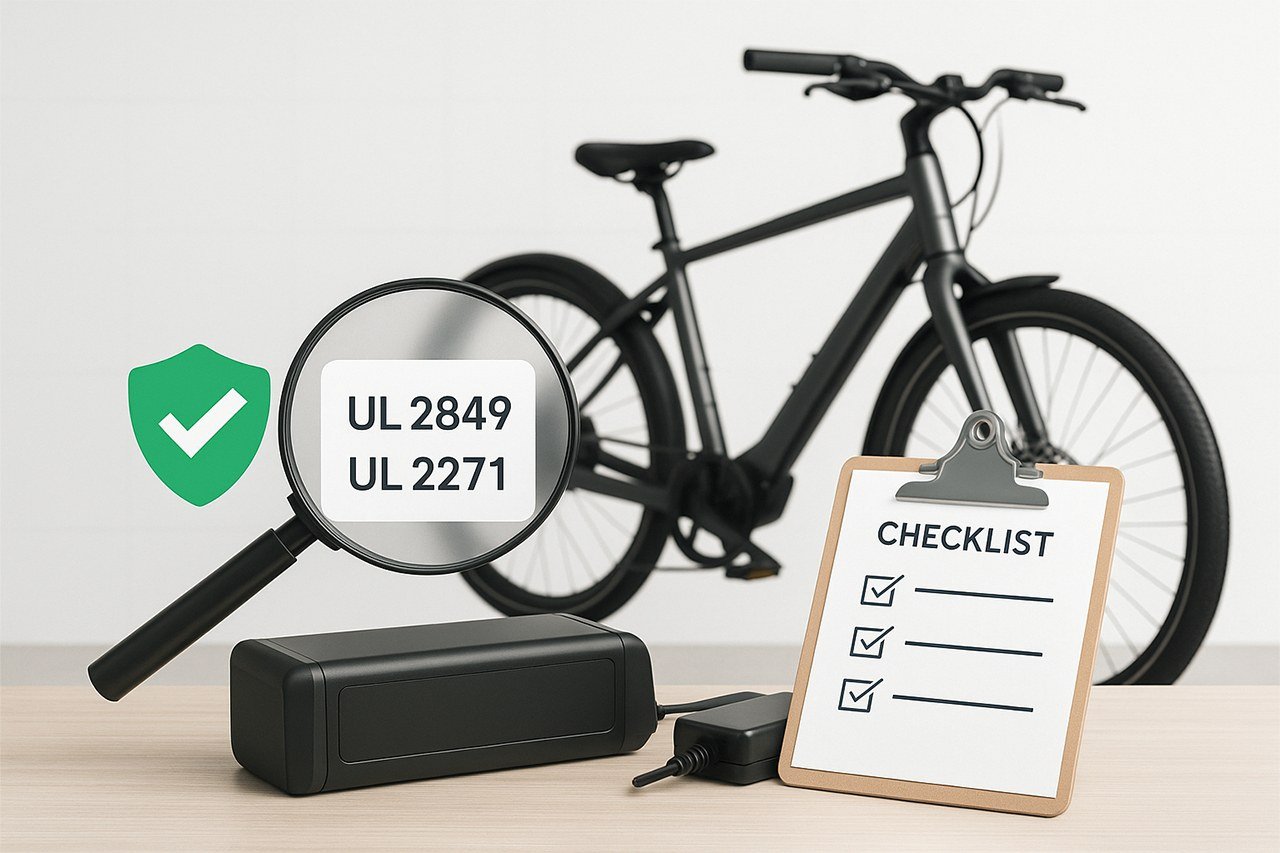
Wondering how to check if an e-bike and its battery are UL-certified? It’s a smart question, especially with so many options on the market and growing concerns about battery safety. A little knowledge goes a long way toward making sure the ride is safe and reliable.
You can confirm UL certification by looking for the UL mark on the battery or the bike itself, checking the product’s manual or packaging, and verifying the listing on UL’s official online database. Certification means the product has passed safety tests under recognized standards, such as UL 2271 for batteries or UL 2849 for complete e-bike systems.
This article will break down why UL certification matters, explain the different standards, and show step-by-step how to confirm certification. It will also cover what manufacturers go through in the process, the risks of aftermarket batteries, and where global safety standards are headed.
Why UL Certification Matters for E-Bikes and Batteries
UL certification plays a key role in e-bike safety because it ensures that batteries and electrical systems meet recognized safety standards. Without it, riders face higher risks of fire hazards, faulty components, and unreliable performance that can put both people and property at risk.
Risks of Non-Certified E-Bike Batteries
Non-certified e-bike batteries often skip the rigorous testing required by organizations like the Consumer Product Safety Commission (CPSC). This means they may not meet safety standards for electrical hazards, overheating, or durability.
Cheap or untested battery packs can fail under normal use. The thin separators inside lithium-ion cells can break down, leading to short circuits or even thermal runaway. Once this chain reaction starts, it can spread quickly through the entire battery pack.
Key risks include:
- Electrical hazards: Short circuits, faulty wiring, or poor insulation
- Fire hazards: Overheating and uncontrolled chemical reactions
- Durability issues: Lower-quality cells with reduced lifespan
Because certification requires strict testing, UL certified batteries are far less likely to suffer from these problems. They provide a measurable level of safety that uncertified products cannot guarantee.
Fire Safety and Real-World Incidents
Battery fires are not just a theoretical risk. News reports show multiple cases of chemical fires linked to uncertified or poorly repaired e-bike batteries. These fires are extremely difficult to extinguish, and fire departments often follow National Fire Protection Association (NFPA) guidelines to let them burn out safely once people are evacuated.
According to Electric Bike Report, testing for UL certification can cost $15,000–$20,000 and requires over 50 battery packs. While expensive, this testing helps prevent the very incidents that have caused deaths and property damage in recent years.
A quick breakdown of fire risks:
| Cause of Fire | Common Scenario | Preventable with UL Certification? |
|---|---|---|
| Thermal runaway | Separator failure inside cells | Yes |
| Poor repairs | Unauthorized battery modifications | Yes |
| Low-cost packs | Cheap cells in scooters/hoverboards | Yes |
These incidents highlight why battery safety is not optional but essential.
Peace of Mind and Consumer Protection
For riders, UL certification is about more than avoiding accidents—it’s about trust. A UL certified e-bike or battery means the product has been independently tested and verified to meet CPSC safety standards.
This gives consumers peace of mind knowing their purchase is less likely to fail. It also protects them legally, since certified products are easier to insure and less likely to be recalled.
Manufacturers benefit too. Selling UL certified e-bikes helps them avoid costly recalls, lawsuits, and negative press. It also shows a commitment to safety that builds long-term trust with customers.
In short, UL certification acts as a safety net for both riders and companies. It reduces risks, prevents battery fires, and ensures that products meet recognized standards before they hit the market.
Understanding UL Certification: The Basics
When someone buys an e-bike, safety often comes down to the battery and electrical system. UL certification is one way to confirm that these parts have been tested to meet strict safety standards, which helps lower the risk of fires, malfunctions, and other hazards.
What Is UL Certification?
UL certification is a safety mark that shows a product has been tested by an independent lab and meets specific safety requirements. For e-bikes, this often means the battery pack and electrical system have gone through rigorous checks for fire resistance, electrical stability, and durability.
Unlike government-mandated rules, UL certification is voluntary. Companies choose to submit their products for testing, which can take 10–12 weeks and cost between $15,000 and $20,000 for batteries, along with dozens of sample packs for testing, according to Electric Bike Report.
For riders, seeing the UL mark on a battery or charger provides reassurance. It doesn’t guarantee a product will never fail, but it shows the manufacturer followed recognized safety protocols. This is especially important with lithium-ion batteries, which can pose fire risks if poorly made or repaired.
Who Are Underwriters Laboratories?
Underwriters Laboratories, often shortened to UL, is a global safety organization that started in 1894. Their role is to create and enforce safety testing standards across industries, from home appliances to industrial systems.
They are not a government agency but an independent, nonprofit company. This independence matters because it ensures testing results are not influenced by manufacturers or regulators. Instead, the focus remains on public safety.
UL works with industries like the e-bike sector to update testing requirements as technology changes. For example, they developed UL 2271 for battery packs and UL 2849 for complete e-bike electrical systems. Each standard targets different risks, which is why the e-bike industry debates which one should apply.
The Role of Safety Standards
Safety standards act as a checklist for how products should perform under stress. For e-bike batteries, this includes testing for:
- Overheating resistance
- Short-circuit protection
- Durability under vibration or impact
- Proper charging and discharging behavior
These steps help prevent thermal runaway, a chain reaction inside lithium-ion cells that can cause fires. Without such standards, low-cost or aftermarket batteries often cut corners, which is why many reported fires involve uncertified products.
By following UL standards, manufacturers show that their products meet an agreed safety threshold. For riders, that means more confidence that their e-bike and its battery won’t become a hazard in daily use.
UL Standards Explained: UL 2271 vs. UL 2849 (and Friends)

Not all UL standards cover the same thing. Some focus only on the e-bike battery, while others test the entire electrical system. A few additional certifications from the U.S. and Europe also play a role in how safe and reliable an electric bike really is.
UL 2271: Battery-Centric Certification
UL 2271 is all about the battery pack itself. It checks how lithium-ion cells perform under stress, such as high heat, vibration, or overcharging. If a battery passes, riders can trust it’s less likely to fail in dangerous ways like thermal runaway.
This standard is especially important because the battery is the most fire-prone part of an e-bike. A UL 2271-certified pack has been tested in a lab, not just by the manufacturer. That means independent experts confirm the safety claims.
Key points about UL 2271:
- Focuses only on the battery pack
- Tests durability, charging safety, and thermal protection
- Requires third-party lab verification
- Marked with the UL logo if certified
When shopping, riders should look for the UL mark printed directly on the battery label. If it only says “tested” or “compliant,” that’s not the same as certified.
UL 2849: System-Wide Certification
UL 2849 goes beyond the battery to evaluate the entire e-bike electrical system. This includes the motor, charger, controller, sensors, and wiring. The goal is to ensure all these parts work safely together without causing overheating, electrical shorts, or other hazards.
Because this testing covers so many components, it is more expensive and time-consuming for manufacturers. But it gives riders extra confidence that the whole bike—not just the battery—meets strict safety standards.
Here’s a quick comparison:
| Standard | Scope | Covers |
|---|---|---|
| UL 2271 | Battery only | Cells, pack design, charging safety |
| UL 2849 | Entire system | Battery, motor, controller, wiring, charger |
Big brands like Bosch and Shimano often pursue UL 2849 because they sell complete drive systems. If one part of the system changes, though, they have to retest the whole setup.
Other Relevant Standards: UL 2580 and EN 15194
While not always mentioned, UL 2580 is another standard related to rechargeable batteries. It was designed for electric vehicles like cars, but some of its testing overlaps with e-bike batteries. It focuses on crash safety, vibration, and long-term durability.
In Europe, EN 15194 is the main e-bike certification. Unlike UL 2271 or UL 2849, it also covers performance features like speed limits and pedal-assist behavior. Many e-bikes sold in the EU must meet this requirement, and in countries like France and the UK, it’s mandatory.
According to Electric Bike Report, EN 15194 includes ISO 4210 bicycle safety rules plus extra tests for e-bike electronics. That makes it one of the most complete standards available.
For riders in the U.S., UL marks are most important. For those in Europe, EN 15194 is the gold standard. Some companies even certify to both, giving buyers peace of mind no matter where they ride.
How to Identify UL-Certified E-Bikes and Batteries
Shoppers can confirm if an e-bike or its battery pack is UL certified by looking for official marks, reviewing paperwork from the manufacturer, and double-checking product details in online listings. Each step helps reduce the chance of buying unsafe or uncertified equipment.
Spotting the UL Logo and Certification Marks
The easiest way to confirm UL certification is to look for the UL logo printed directly on the product. On e-bikes, this might appear on the frame near the motor system or on the battery housing. For battery packs, the logo is often located on the label with other safety information.
Not every logo is legitimate, so it’s worth paying attention to details. A proper UL mark should include:
- The UL symbol (a circle with “UL” inside)
- The word “Listed” or “Recognized”
- A unique control number or file number
Counterfeit marks sometimes leave out these details or use a slightly different design. If the logo looks blurry, off-center, or incomplete, it may not be genuine.
Checking Manufacturer Documentation
Manufacturers of UL certified e-bikes and UL certified batteries usually provide documentation that confirms testing. This can include a certificate, a compliance statement, or a technical sheet that lists the safety standard met, such as UL 2271 for battery packs or UL 2849 for complete e-bike systems.
When reviewing paperwork, it’s helpful to look for:
| Item | What to Check |
|---|---|
| Standard Number | UL 2271 (batteries) or UL 2849 (systems) |
| Certificate Number | Should match the UL database |
| Manufacturer Name | Must match the brand on the product |
If the seller cannot provide this documentation, that’s a red flag. Reputable companies like Bosch and Brose make their UL certifications easy to find and verify.
Verifying Certification in Online Listings
When shopping online for electric bikes or replacement battery packs, it’s important to verify safety claims. Many retailers list “UL certified” in product descriptions, but this should always be cross-checked.
Buyers can confirm by:
- Looking for the UL certification number in the listing
- Checking the seller’s official website for matching details
- Comparing the product against UL’s official certification database
If an online listing claims UL certification but doesn’t provide a number or supporting details, the claim may not be reliable. A true UL certified product will have consistent information across packaging, documentation, and online listings.
Step-by-Step: Checking Your E-Bike and Battery for Certification

A rider can confirm UL certification by looking at the electrical system, checking the battery pack labels, and reaching out to the seller or brand for proof. Each step helps avoid guesswork and ensures the e-bike meets recognized safety standards.
Inspecting Your E-Bike’s Electrical System
Start with the wiring and control unit. A certified system usually has a UL 2849 marking, which applies to the full e-bike electrical drive system. This includes the motor, controller, display, and wiring harness.
Look for a permanent label or sticker near the bottom bracket, frame, or motor housing. Brands like Bosch often place the certification mark on or near the drive unit. If it’s missing, that’s a red flag.
Check for these key details on the label:
- UL logo (must be printed, not a cheap-looking sticker)
- Standard number (UL 2849 for systems)
- Manufacturer name (like Bosch or Aventon)
- Model number (matches your bike’s manual)
If the label is scratched off or looks fake, contact the brand before riding. A real certification label is always clear, durable, and easy to read.
Examining the Battery Pack for Labels
The battery pack is just as important as the motor system. A safe e-bike battery usually shows UL 2271 certification, which applies to rechargeable lithium-ion packs.
Look along the side or bottom of the battery casing for a printed UL logo. Some packs also include a QR code that links to a certification page. If the pack is removable, check both the casing and the charging port area.
Here’s what to confirm on the battery label:
| Label Detail | What It Means |
|---|---|
| UL 2271 | Battery pack safety standard |
| UL logo | Verified by UL, not self-claimed |
| Serial number | Unique to your battery |
| Brand name | Matches your bike brand (Aventon, Bosch, etc.) |
If the label is missing, avoid guessing. Many uncertified batteries look similar to certified ones, but they don’t meet the same safety checks.
Contacting the Manufacturer or Retailer
If the labels are unclear, the next step is to ask the seller or brand directly. Most major companies like Aventon or Bosch can confirm certification through their customer service teams.
When contacting them, provide your bike’s model number and battery serial number. This helps them quickly verify if your unit passed UL testing.
Questions to ask include:
- Is my specific model UL 2849 certified?
- Is the battery pack UL 2271 certified?
- Can you send me the certification file or link?
If the seller avoids the question or cannot provide proof, that’s a warning sign. Reliable retailers will share documentation or direct you to UL’s official database.
By confirming with the manufacturer, riders avoid relying only on labels, which can sometimes be copied or misleading.
The Certification Process: What Manufacturers Go Through
When an e-bike or its battery is labeled as UL-certified, it means the product has gone through a structured and often expensive process. Manufacturers must meet strict safety standards, prove their designs can handle stress, and agree to ongoing checks to keep that certification valid.
Testing Procedures and Safety Protocols
Manufacturers can’t just test products in their own labs and call it a day. To earn UL certification, they must send their e-bike systems or batteries to accredited third-party labs approved by Underwriters Laboratories. These labs follow detailed test methods designed to catch problems before a product reaches the market.
For example, UL 2271 focuses on battery safety, checking for overheating, short circuits, and fire risks. UL 2849 goes further, testing the entire electrical system—battery, motor, charger, wiring, and controls—working together under real-world conditions.
The tests simulate worst-case scenarios:
- Extreme heat or cold
- Overcharging and deep discharging
- Water and dust exposure
- Electrical faults like short circuits
This isn’t about proving a bike works on a sunny day—it’s about proving it won’t fail in less-than-ideal conditions. That’s why UL standards for e-bikes are trusted across the industry.
Timeframes and Costs Involved
Certification is not quick or cheap. Depending on the system, testing can take several months. If a manufacturer changes even one part—like swapping a display or battery size—the whole system may need retesting.
Costs vary, but they usually run into tens of thousands of dollars. For smaller companies, this is a huge investment. Larger brands like Bosch or Shimano can afford to certify entire systems, while smaller startups may only certify batteries first.
A simple breakdown:
| Process | Typical Timeframe | Cost Range |
|---|---|---|
| Battery testing (UL 2271) | 2–4 months | $10,000–$30,000 |
| Full system (UL 2849) | 4–8 months | $30,000–$100,000+ |
This explains why not every e-bike on the market is UL-certified yet, even though demand is growing.
Ongoing Compliance and Audits
Certification doesn’t end once a product passes. Manufacturers must agree to regular audits by UL or another accredited lab. These audits confirm that production models match the tested samples and that no shortcuts are taken during mass production.
If a company fails an audit, it risks losing its certification. That means the UL logo is more than a one-time stamp—it’s a promise that the product continues to meet safety standards over time.
Audits often include:
- Reviewing factory processes
- Inspecting random product samples
- Checking for design or material changes
- Verifying quality-control systems
This ongoing oversight gives buyers confidence that a certified e-bike or battery is not only safe when first tested, but also safe years later when rolling off the production line.
Aftermarket Batteries and Common Pitfalls

Aftermarket e-bike batteries can be tempting because they’re often cheaper and easy to find online. But cutting corners here can lead to safety issues, poor performance, and even fire risks if the battery doesn’t meet UL standards. Paying attention to certification labels and buying from trusted sellers makes a big difference.
Risks of Using Non-Certified Replacement Batteries
Non-certified aftermarket batteries may look the same as the original, but inside they often use lower quality cells and weaker safety controls. This increases the chance of electrical malfunctions, overheating, or even battery fires that are very difficult to put out.
Many of the fires reported in the news come from low-cost devices or batteries that were repaired without approval from the manufacturer. According to Electric Bike Report, most incidents involve poorly built packs that lack proper testing.
A certified battery must pass strict UL standards such as UL 2271, which focuses on battery packs, or UL 2849, which tests the full e-bike system. Without these tests, there’s no guarantee the pack can handle charging, vibration, or heat safely.
Common problems with non-certified batteries:
- Cells overheating during charging
- Shortened lifespan due to poor construction
- Risk of thermal runaway and fire spread
- Chargers that don’t match the pack’s safety needs
How to Avoid Fake or Misleading Certifications
Some aftermarket sellers use fake UL logos or misleading claims. A real UL-certified battery will have a UL mark along with a control number that can be verified on UL’s official database. If that number is missing, the certification is not valid.
Shoppers should also check the packaging and labeling. Misspelled words, vague safety claims, or missing manufacturer details are red flags. A genuine pack will clearly list the maker, model, and voltage.
Practical steps to avoid fakes:
- Buy only from trusted retailers or directly from the e-bike brand.
- Cross-check the UL control number online.
- Avoid deals that seem too cheap compared to official replacements.
- Confirm the charger is also UL-certified and matched to the pack.
By sticking to verified products, riders can reduce the risk of fires and keep their e-bike running safely.
Global Standards and Future Trends in E-Bike Safety
Electric bikes and scooters are becoming part of daily travel in many cities, but their batteries and electrical systems raise safety concerns. Different regions are adopting their own rules, and manufacturers must keep up with both international standards and new local laws.
International Certification Standards
E-bike safety testing is not the same worldwide. In Europe, EN 15194 is the main standard for electrically assisted bicycles. It focuses on performance, battery safety, and mechanical durability. In the United States, UL 2849 covers the entire electrical system of an e-bike, while UL 2271 applies specifically to battery packs.
Other standards also play a role:
| Standard | Applies To | Region/Use |
|---|---|---|
| UL 2580 | Batteries in electric vehicles | North America |
| UL 2054 | General battery packs | Global |
| EN 15194 | E-bikes | Europe |
| UL 2849 | E-bike electrical systems | U.S. |
| UL 2271 | Light e-mobility batteries | U.S./Canada |
Unlike Europe, the U.S. requires certification through accredited labs such as OSHA-approved NRTLs. Some cities, like New York City, now legally require e-bikes sold or rented to carry UL 2849 certification from an accredited lab, making compliance more than just a best practice. You can read more about these requirements from SGS on UL 2849.
Emerging Regulations and Industry Shifts
Governments are reacting to fire risks linked to lithium-ion batteries. In 2023, California passed a law allowing compliance through either UL 2849 or EN 15194, while Toronto requires UL or CE-certified batteries. Cities like San Francisco are considering similar rules.
This shift means manufacturers can’t just rely on component-level certification. Entire e-bike systems must be tested, even if the motor or battery already meets a standard. For example, New York City requires the finished e-bike to hold UL 2849 certification, not just its parts.
Industry-wide, more brands are moving toward third-party certification. Testing labs now offer bundled services, checking both the bike and its battery system for compliance. This helps reduce delays and avoids mismatches between certified components and uncertified final products.
As more regions adopt stricter rules, buyers will likely see clearer safety labels on packaging and e-bike frames. This trend makes it easier for riders to confirm that their electric bikes meet internationally recognized safety standards.
Frequently Asked Questions
Checking if an e-bike or battery is UL-certified comes down to looking for the right labels, knowing which standards apply, and understanding what those standards actually mean. Certification isn’t just a sticker—it’s proof that the product has been tested for safety under specific conditions.
What’s the secret handshake to verify my e-bike’s UL certification status?
There’s no secret handshake, just a label. Manufacturers place a UL mark directly on the product or in the manual.
If the UL logo is missing, the bike or battery is not certified. To double-check, riders can also search the UL database online for the product’s certification number.
Can I trust my e-bike battery not to start a fireworks show? How do I check for UL certification?
Trust comes from testing, not luck. A certified battery will carry the UL mark, often printed on the battery casing.
The most common standard for e-bike batteries is UL 2271, which focuses on lithium-ion battery safety. If that number shows up on the label, the battery has passed safety checks for things like thermal runaway and short circuits.
Is there a UL certification crystal ball for e-bikes and batteries in the USA?
No crystal ball needed—just two main standards. UL 2271 covers battery packs, while UL 2849 tests the entire e-bike electrical system.
A quick way to remember:
- UL 2849 = full system check
- UL 2271 = battery only
Are all e-bikes wired for safety, or do they need a UL blessing?
Not all e-bikes are UL-certified. Certification is voluntary in many places, though some U.S. cities and workplaces now require it.
Without UL testing, there’s no guarantee the system meets recognized safety standards. Riders should look for UL 2849 if they want assurance that the motor, battery, and charger all work safely together.
Do lithium batteries come with a UL superhero cape, or how can I confirm they’re certified?
Lithium batteries don’t wear capes, but they should carry a UL mark. The mark is usually on the battery housing or printed in the product manual.
If the battery is aftermarket or from a low-cost brand, certification is less common. Those are the batteries most often linked to fire risks in news reports.
Where’s the ‘UL Certified’ stamp hiding on my e-bike or battery?
The UL mark is usually small but visible. Common spots include:
- Battery casing
- Charger housing
- Inside the owner’s manual
- Product packaging
If none of these show the UL logo, the product likely isn’t certified. Always ask the seller for proof if you don’t see it.
Final Thoughts
When it comes to figuring out if an e-bike and battery are UL-certified, the process isn’t as complicated as it sounds. Riders just need to look for the UL mark on the product or packaging. If it’s missing, that’s usually a sign the battery hasn’t gone through testing.
Certification matters because it shows the battery has been tested for safety standards. Without it, riders risk buying a product that may not meet the same level of protection against issues like overheating or fire. According to Electric Bike Report, testing can take 10–12 weeks and cost $15,000–$20,000, which explains why some companies skip it.
Here’s a quick reminder of what to check:
- Look for the UL logo on the battery or charger.
- Check the model number against UL’s online database.
- Ask the seller directly for proof of certification.
- Be cautious with aftermarket batteries since many fires come from uncertified replacements.
| What to Check | Why It Matters |
|---|---|
| UL logo | Confirms certification |
| Model number | Matches UL records |
| Seller info | Ensures transparency |
By taking a few minutes to confirm whether an e-bike battery is UL-certified, riders protect both their safety and their investment. It’s a small step that can prevent much bigger problems down the road.

